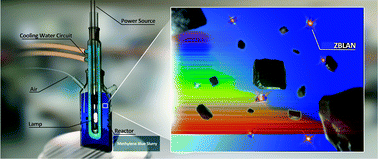Turning into the blue: materials for enhancing TiO2 photocatalysis by up-conversion photonics†
Abstract
We have explored the emerging and ground-breaking photonics approach to enhance the photocatalytic activity of one of the main semiconductor electrodes used in water-splitting reactions, titanium dioxide (TiO2): the blue shifting of the incident radiation by means of a highly efficient up-conversion by a rare-earth (RE) doped luminescent material to assist in the harvesting of long wavelengths in unused portions of infrared light. We present an up to 20% improvement of the photocatalytic action of the commercial benchmark TiO2 efficient photocatalyst in the decomposition of methylene blue in water under Xe-lamp irradiation, and also an outstanding enhancement by a factor of about 2.5 of the photolytic degradation rate of this pollutant. Our results prove that the ultraviolet (UV) radiation that reaches the TiO2 particles is increased by the addition of the RE-doped powder material into a slurry-type photo-reactor, boosting both the photocatalytic and photolytic degradation rates. Thus, we show the feasibility of handling and transforming the incoming infrared radiation, bridging the UV gap of the photocatalytic semiconductor. Let us turn the infrared into the blue; there is plenty of energy at the bottom.


 Please wait while we load your content...
Please wait while we load your content...